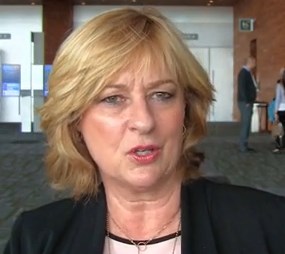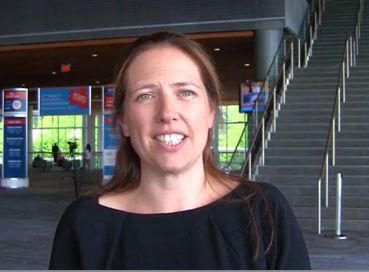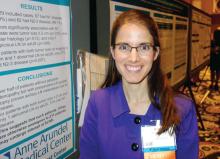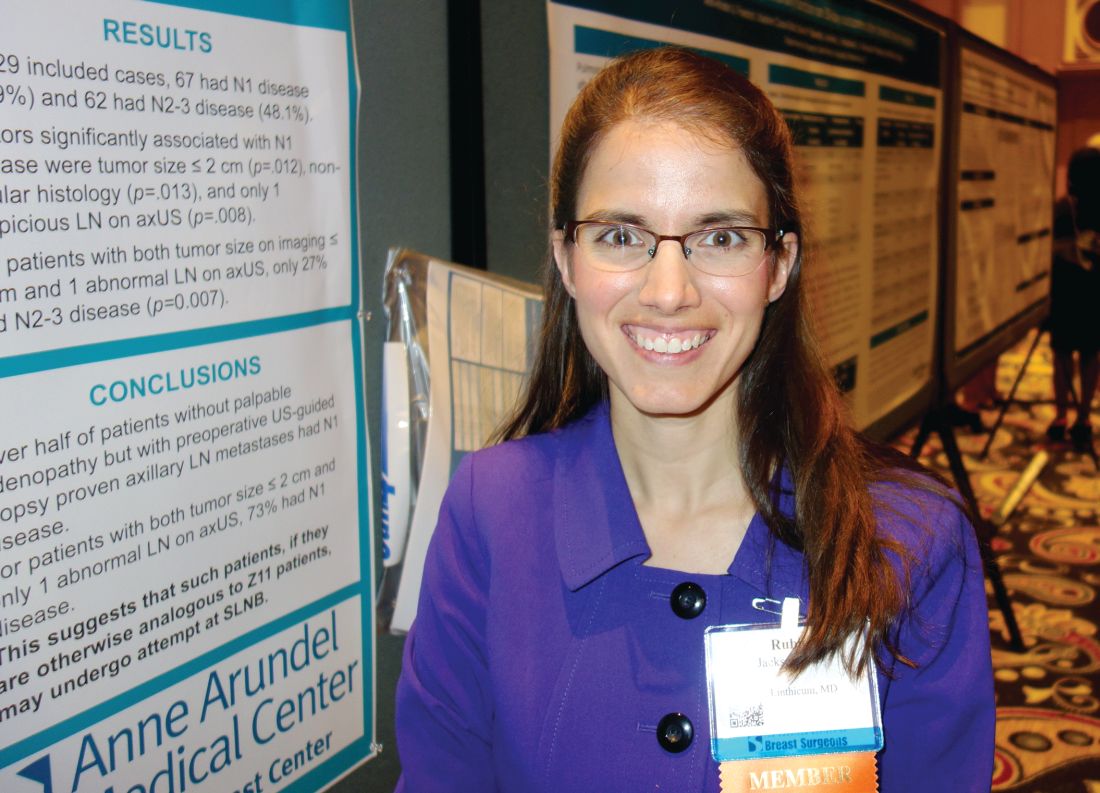User login
M. Alexander Otto began his reporting career early in 1999 covering the pharmaceutical industry for a national pharmacists' magazine and freelancing for the Washington Post and other newspapers. He then joined BNA, now part of Bloomberg News, covering health law and the protection of people and animals in medical research. Alex next worked for the McClatchy Company. Based on his work, Alex won a year-long Knight Science Journalism Fellowship to MIT in 2008-2009. He joined the company shortly thereafter. Alex has a newspaper journalism degree from Syracuse (N.Y.) University and a master's degree in medical science -- a physician assistant degree -- from George Washington University. Alex is based in Seattle.
VIDEO: School program aims to cut diagnostic delay in endometriosis
VANCOUVER – Although symptoms can start young in endometriosis – sometimes in adolescence – women often suffer for years from bowel problems, pain, dyspareunia, and other complications before the condition is recognized and addressed.
Endometriosis can be “a monster of a disease,” especially if it’s not recognized early, said Deborah Bush, cofounder and CEO of the patient advocacy group Endometriosis New Zealand.
To help, she and her colleagues started an education program in New Zealand to teach secondary school students how to recognize – and seek help – when menstrual symptoms fall outside the norm.
In an interview at the World Congress on Endometriosis, Ms. Bush explained the importance of such efforts, and the impact they’ve had in New Zealand over the past 20 years (Aust N Z J Obstet Gynaecol. 2017 Mar 28. doi: 10.1111/ajo.12614).
She also gave an example from her own endometriosis consulting practice of what it took to turn around a patient who had been suffering with the disease for 15 years. Treatment had to move far beyond pelvic lesions.
The video associated with this article is no longer available on this site. Please view all of our videos on the MDedge YouTube channel
VANCOUVER – Although symptoms can start young in endometriosis – sometimes in adolescence – women often suffer for years from bowel problems, pain, dyspareunia, and other complications before the condition is recognized and addressed.
Endometriosis can be “a monster of a disease,” especially if it’s not recognized early, said Deborah Bush, cofounder and CEO of the patient advocacy group Endometriosis New Zealand.
To help, she and her colleagues started an education program in New Zealand to teach secondary school students how to recognize – and seek help – when menstrual symptoms fall outside the norm.
In an interview at the World Congress on Endometriosis, Ms. Bush explained the importance of such efforts, and the impact they’ve had in New Zealand over the past 20 years (Aust N Z J Obstet Gynaecol. 2017 Mar 28. doi: 10.1111/ajo.12614).
She also gave an example from her own endometriosis consulting practice of what it took to turn around a patient who had been suffering with the disease for 15 years. Treatment had to move far beyond pelvic lesions.
The video associated with this article is no longer available on this site. Please view all of our videos on the MDedge YouTube channel
VANCOUVER – Although symptoms can start young in endometriosis – sometimes in adolescence – women often suffer for years from bowel problems, pain, dyspareunia, and other complications before the condition is recognized and addressed.
Endometriosis can be “a monster of a disease,” especially if it’s not recognized early, said Deborah Bush, cofounder and CEO of the patient advocacy group Endometriosis New Zealand.
To help, she and her colleagues started an education program in New Zealand to teach secondary school students how to recognize – and seek help – when menstrual symptoms fall outside the norm.
In an interview at the World Congress on Endometriosis, Ms. Bush explained the importance of such efforts, and the impact they’ve had in New Zealand over the past 20 years (Aust N Z J Obstet Gynaecol. 2017 Mar 28. doi: 10.1111/ajo.12614).
She also gave an example from her own endometriosis consulting practice of what it took to turn around a patient who had been suffering with the disease for 15 years. Treatment had to move far beyond pelvic lesions.
The video associated with this article is no longer available on this site. Please view all of our videos on the MDedge YouTube channel
AT WCE 2017
VIDEO: Endometriosis research: What women want
VANCOUVER – To define the top 10 research priorities in endometriosis, researchers at the University of Edinburgh, Scotland, and their colleagues did something unusual in the world of medical science. They asked the women who have the disease.
More than 70% of the 1,225 people initially surveyed to define what most needs to be figured out in endometriosis were patients, and most of the rest were clinicians who take care of them. Patients were involved throughout an exhaustive process that whittled down nearly 5,000 initial suggestions to a list of 10 priorities.
The first priority is to determine if endometriosis can be cured, and the second task is to find its cause (Lancet. 2017 May 18. doi: 10.1016/S0140-6736(17)31344-2).
Women who have endometriosis said they want a noninvasive diagnostic test. They also want help managing the emotional and physical impacts of living with the disease, not simply treatments that focus on lesions, according to Andrew Horne, MBChB, PhD, a professor of gynecology and reproductive sciences at the University of Edinburgh, who led the efforts.
In an interview at the World Congress on Endometriosis, Dr. Horne explained why it’s critical to define the top research priorities and what doing so could mean for patients and doctors. He also explained the importance of a recent insight into the pathogenesis of endometriosis: It behaves like cancer.
The video associated with this article is no longer available on this site. Please view all of our videos on the MDedge YouTube channel
VANCOUVER – To define the top 10 research priorities in endometriosis, researchers at the University of Edinburgh, Scotland, and their colleagues did something unusual in the world of medical science. They asked the women who have the disease.
More than 70% of the 1,225 people initially surveyed to define what most needs to be figured out in endometriosis were patients, and most of the rest were clinicians who take care of them. Patients were involved throughout an exhaustive process that whittled down nearly 5,000 initial suggestions to a list of 10 priorities.
The first priority is to determine if endometriosis can be cured, and the second task is to find its cause (Lancet. 2017 May 18. doi: 10.1016/S0140-6736(17)31344-2).
Women who have endometriosis said they want a noninvasive diagnostic test. They also want help managing the emotional and physical impacts of living with the disease, not simply treatments that focus on lesions, according to Andrew Horne, MBChB, PhD, a professor of gynecology and reproductive sciences at the University of Edinburgh, who led the efforts.
In an interview at the World Congress on Endometriosis, Dr. Horne explained why it’s critical to define the top research priorities and what doing so could mean for patients and doctors. He also explained the importance of a recent insight into the pathogenesis of endometriosis: It behaves like cancer.
The video associated with this article is no longer available on this site. Please view all of our videos on the MDedge YouTube channel
VANCOUVER – To define the top 10 research priorities in endometriosis, researchers at the University of Edinburgh, Scotland, and their colleagues did something unusual in the world of medical science. They asked the women who have the disease.
More than 70% of the 1,225 people initially surveyed to define what most needs to be figured out in endometriosis were patients, and most of the rest were clinicians who take care of them. Patients were involved throughout an exhaustive process that whittled down nearly 5,000 initial suggestions to a list of 10 priorities.
The first priority is to determine if endometriosis can be cured, and the second task is to find its cause (Lancet. 2017 May 18. doi: 10.1016/S0140-6736(17)31344-2).
Women who have endometriosis said they want a noninvasive diagnostic test. They also want help managing the emotional and physical impacts of living with the disease, not simply treatments that focus on lesions, according to Andrew Horne, MBChB, PhD, a professor of gynecology and reproductive sciences at the University of Edinburgh, who led the efforts.
In an interview at the World Congress on Endometriosis, Dr. Horne explained why it’s critical to define the top research priorities and what doing so could mean for patients and doctors. He also explained the importance of a recent insight into the pathogenesis of endometriosis: It behaves like cancer.
The video associated with this article is no longer available on this site. Please view all of our videos on the MDedge YouTube channel
AT WCE 2017
Breast cancer liquid biopsies don’t change outcomes....yet
LAS VEGAS – Although circulating tumor cells are prognostic in breast cancer, they aren’t likely to become a part of routine practice until they’ve been shown to improve outcomes, and that hasn’t happened yet, according to Anthony Lucci, MD, professor of breast surgical oncology at MD Anderson Cancer Center, Houston.
MD Anderson and other institutions have established that in breast cancer, from baseline through treatment follow-up, the presence of circulating tumor cells (CTCs) in the blood predicts worse outcomes in both metastatic and local disease, even among women who have a pathologic complete response to treatment.
That knowledge has not yet translated into better outcomes. In a pivotal trial, survival was no better in metastatic breast cancer when women were switched to an alternative chemotherapy regimen after their CTC levels did not fall in response to first-line treatment, compared with women who remained on their initial agent despite persistently high CTCs (J Clin Oncol. 2014 Nov 1;32[31]:3483-9).
“When we tried to switch chemotherapy” based on CTCs, “it really didn’t make a difference, so no one is really quite sure yet what to do with this information. We can’t tell a patient that they are likely to have a much worse outcome, but there’s nothing we can do about it,” and “I don’t think payers will pay” for CTC testing in breast cancer until “we establish a predictive benefit, and show what agents will reduce CTCs and improve outcomes,” Dr. Lucci said at the American Society of Breast Surgeons annual meeting.
Even so, the promise of CTCs as a clinical tool is too great to abandon research, and work continues at MD Anderson and elsewhere. It’s thought that tumor cells in the blood aren’t simply a marker of disease, but rather microscopic disease in themselves that contributes to recurrence and progression. It’s possible that cells shed by tumors lie dormant in the bone marrow, then reactivate and reseed the original tumor site or give rise to distant metastases.
CTCs are similar to tumor cells that have been found in the bone marrow of women with apparently quiescent breast cancer, but finding them in the blood means “you don’t have to poke a needle in someone’s bone. You can just take a sample of their blood, and it tells you the same information,” Dr. Lucci said.
CTCs have been shown in breast cancer to rise and fall depending on tumor response. “In the future, I do think we will [use them] as a serial monitoring tool and a guide to therapy.” There might even be a role for breast cancer screening, he said.
Analyzing the blood for evidence of solid tumors – popularly called “liquid biopsy” – has shown benefits in a variety of cancers, particularly for identifying disease, and in some cases mutations, sooner than with conventional methods. Science is catching up to the old-school notion that cancer spreads through the blood.
Another approach is to look for circulating tumor DNA, which has been shown to be useful for early detection in gynecologic cancers. The idea is that a few tumor cells shatter and spill their genetic material into the blood early on. “In the majority of breast cancer patients,” however, “you don’t find actionable mutations” with circulating tumor DNA, especially in earlier-stage, nonmetastatic disease. “There’s not enough DNA released into the blood,” Dr. Lucci said.
But “we need to be monitoring the blood on a routine basis” for breast cancer clues. “That, I think, is the wave of the future. Just looking at x-rays and waiting for something to happen is too late,” he said.
Dr. Lucci had no disclosures related to his talk.
LAS VEGAS – Although circulating tumor cells are prognostic in breast cancer, they aren’t likely to become a part of routine practice until they’ve been shown to improve outcomes, and that hasn’t happened yet, according to Anthony Lucci, MD, professor of breast surgical oncology at MD Anderson Cancer Center, Houston.
MD Anderson and other institutions have established that in breast cancer, from baseline through treatment follow-up, the presence of circulating tumor cells (CTCs) in the blood predicts worse outcomes in both metastatic and local disease, even among women who have a pathologic complete response to treatment.
That knowledge has not yet translated into better outcomes. In a pivotal trial, survival was no better in metastatic breast cancer when women were switched to an alternative chemotherapy regimen after their CTC levels did not fall in response to first-line treatment, compared with women who remained on their initial agent despite persistently high CTCs (J Clin Oncol. 2014 Nov 1;32[31]:3483-9).
“When we tried to switch chemotherapy” based on CTCs, “it really didn’t make a difference, so no one is really quite sure yet what to do with this information. We can’t tell a patient that they are likely to have a much worse outcome, but there’s nothing we can do about it,” and “I don’t think payers will pay” for CTC testing in breast cancer until “we establish a predictive benefit, and show what agents will reduce CTCs and improve outcomes,” Dr. Lucci said at the American Society of Breast Surgeons annual meeting.
Even so, the promise of CTCs as a clinical tool is too great to abandon research, and work continues at MD Anderson and elsewhere. It’s thought that tumor cells in the blood aren’t simply a marker of disease, but rather microscopic disease in themselves that contributes to recurrence and progression. It’s possible that cells shed by tumors lie dormant in the bone marrow, then reactivate and reseed the original tumor site or give rise to distant metastases.
CTCs are similar to tumor cells that have been found in the bone marrow of women with apparently quiescent breast cancer, but finding them in the blood means “you don’t have to poke a needle in someone’s bone. You can just take a sample of their blood, and it tells you the same information,” Dr. Lucci said.
CTCs have been shown in breast cancer to rise and fall depending on tumor response. “In the future, I do think we will [use them] as a serial monitoring tool and a guide to therapy.” There might even be a role for breast cancer screening, he said.
Analyzing the blood for evidence of solid tumors – popularly called “liquid biopsy” – has shown benefits in a variety of cancers, particularly for identifying disease, and in some cases mutations, sooner than with conventional methods. Science is catching up to the old-school notion that cancer spreads through the blood.
Another approach is to look for circulating tumor DNA, which has been shown to be useful for early detection in gynecologic cancers. The idea is that a few tumor cells shatter and spill their genetic material into the blood early on. “In the majority of breast cancer patients,” however, “you don’t find actionable mutations” with circulating tumor DNA, especially in earlier-stage, nonmetastatic disease. “There’s not enough DNA released into the blood,” Dr. Lucci said.
But “we need to be monitoring the blood on a routine basis” for breast cancer clues. “That, I think, is the wave of the future. Just looking at x-rays and waiting for something to happen is too late,” he said.
Dr. Lucci had no disclosures related to his talk.
LAS VEGAS – Although circulating tumor cells are prognostic in breast cancer, they aren’t likely to become a part of routine practice until they’ve been shown to improve outcomes, and that hasn’t happened yet, according to Anthony Lucci, MD, professor of breast surgical oncology at MD Anderson Cancer Center, Houston.
MD Anderson and other institutions have established that in breast cancer, from baseline through treatment follow-up, the presence of circulating tumor cells (CTCs) in the blood predicts worse outcomes in both metastatic and local disease, even among women who have a pathologic complete response to treatment.
That knowledge has not yet translated into better outcomes. In a pivotal trial, survival was no better in metastatic breast cancer when women were switched to an alternative chemotherapy regimen after their CTC levels did not fall in response to first-line treatment, compared with women who remained on their initial agent despite persistently high CTCs (J Clin Oncol. 2014 Nov 1;32[31]:3483-9).
“When we tried to switch chemotherapy” based on CTCs, “it really didn’t make a difference, so no one is really quite sure yet what to do with this information. We can’t tell a patient that they are likely to have a much worse outcome, but there’s nothing we can do about it,” and “I don’t think payers will pay” for CTC testing in breast cancer until “we establish a predictive benefit, and show what agents will reduce CTCs and improve outcomes,” Dr. Lucci said at the American Society of Breast Surgeons annual meeting.
Even so, the promise of CTCs as a clinical tool is too great to abandon research, and work continues at MD Anderson and elsewhere. It’s thought that tumor cells in the blood aren’t simply a marker of disease, but rather microscopic disease in themselves that contributes to recurrence and progression. It’s possible that cells shed by tumors lie dormant in the bone marrow, then reactivate and reseed the original tumor site or give rise to distant metastases.
CTCs are similar to tumor cells that have been found in the bone marrow of women with apparently quiescent breast cancer, but finding them in the blood means “you don’t have to poke a needle in someone’s bone. You can just take a sample of their blood, and it tells you the same information,” Dr. Lucci said.
CTCs have been shown in breast cancer to rise and fall depending on tumor response. “In the future, I do think we will [use them] as a serial monitoring tool and a guide to therapy.” There might even be a role for breast cancer screening, he said.
Analyzing the blood for evidence of solid tumors – popularly called “liquid biopsy” – has shown benefits in a variety of cancers, particularly for identifying disease, and in some cases mutations, sooner than with conventional methods. Science is catching up to the old-school notion that cancer spreads through the blood.
Another approach is to look for circulating tumor DNA, which has been shown to be useful for early detection in gynecologic cancers. The idea is that a few tumor cells shatter and spill their genetic material into the blood early on. “In the majority of breast cancer patients,” however, “you don’t find actionable mutations” with circulating tumor DNA, especially in earlier-stage, nonmetastatic disease. “There’s not enough DNA released into the blood,” Dr. Lucci said.
But “we need to be monitoring the blood on a routine basis” for breast cancer clues. “That, I think, is the wave of the future. Just looking at x-rays and waiting for something to happen is too late,” he said.
Dr. Lucci had no disclosures related to his talk.
AT ASBS 2017
VIDEO: How to recognize, treat central sensitization in endometriosis
VANCOUVER – Sometimes in endometriosis, pain persists despite optimal treatment. Women have multiple lesion excisions, but the pain just doesn’t go away.
Evidence is building that in those cases, central sensitization – an amplified central nervous system pain response common in chronic pain syndromes – is playing a role.
In a video interview at the World Congress on Endometriosis, Katy Vincent, DPhil, MBBS, a senior pain fellow and consultant gynecologist at the University of Oxford, England, explained the latest thinking, as well as how to recognize and treat central sensitization in endometriosis. For some women, focusing on lesions isn’t enough.
The video associated with this article is no longer available on this site. Please view all of our videos on the MDedge YouTube channel
VANCOUVER – Sometimes in endometriosis, pain persists despite optimal treatment. Women have multiple lesion excisions, but the pain just doesn’t go away.
Evidence is building that in those cases, central sensitization – an amplified central nervous system pain response common in chronic pain syndromes – is playing a role.
In a video interview at the World Congress on Endometriosis, Katy Vincent, DPhil, MBBS, a senior pain fellow and consultant gynecologist at the University of Oxford, England, explained the latest thinking, as well as how to recognize and treat central sensitization in endometriosis. For some women, focusing on lesions isn’t enough.
The video associated with this article is no longer available on this site. Please view all of our videos on the MDedge YouTube channel
VANCOUVER – Sometimes in endometriosis, pain persists despite optimal treatment. Women have multiple lesion excisions, but the pain just doesn’t go away.
Evidence is building that in those cases, central sensitization – an amplified central nervous system pain response common in chronic pain syndromes – is playing a role.
In a video interview at the World Congress on Endometriosis, Katy Vincent, DPhil, MBBS, a senior pain fellow and consultant gynecologist at the University of Oxford, England, explained the latest thinking, as well as how to recognize and treat central sensitization in endometriosis. For some women, focusing on lesions isn’t enough.
The video associated with this article is no longer available on this site. Please view all of our videos on the MDedge YouTube channel
EXPERT ANALYSIS FROM THE WORLD CONGRESS ON ENDOMETRIOSIS
VIDEO: When to offer hysterectomy in endometriosis
VANCOUVER – Although hysterectomy will never again be the go-to treatment for endometriosis that it once was, it has become clear in recent years that it still has a role to play.
In a video interview at the World Congress on Endometriosis, Ray Garry, MD, a recently retired professor of obstetrics and gynecology at the University of Western Australia, Perth, explained why – in a limited way – the pendulum is swinging back toward hysterectomy for a select group of women.
The video associated with this article is no longer available on this site. Please view all of our videos on the MDedge YouTube channel
VANCOUVER – Although hysterectomy will never again be the go-to treatment for endometriosis that it once was, it has become clear in recent years that it still has a role to play.
In a video interview at the World Congress on Endometriosis, Ray Garry, MD, a recently retired professor of obstetrics and gynecology at the University of Western Australia, Perth, explained why – in a limited way – the pendulum is swinging back toward hysterectomy for a select group of women.
The video associated with this article is no longer available on this site. Please view all of our videos on the MDedge YouTube channel
VANCOUVER – Although hysterectomy will never again be the go-to treatment for endometriosis that it once was, it has become clear in recent years that it still has a role to play.
In a video interview at the World Congress on Endometriosis, Ray Garry, MD, a recently retired professor of obstetrics and gynecology at the University of Western Australia, Perth, explained why – in a limited way – the pendulum is swinging back toward hysterectomy for a select group of women.
The video associated with this article is no longer available on this site. Please view all of our videos on the MDedge YouTube channel
EXPERT ANALYSIS FROM THE WORLD CONGRESS ON ENDOMETRIOSIS
VIDEO: Use oil-based contrast for HSG fertility boost
VANCOUVER – Ongoing pregnancies and live births were substantially higher when oil-based contrast, instead of water-based contrast, was used for hysterosalpingography (HSG) in a randomized trial at 27 hospitals in the Netherlands.
It’s long been known that HSG, commonly used to assess reproductive tract patency, also improves fertility, perhaps by immunologic effects or simply by flushing debris and mucus out of the fallopian tubes. Until now, however, it’s been unclear if oil or water contrast boosts fertility the most.
To find out, investigators randomized 554 infertile women scheduled for HSG to poppy seed oil contrast (Lipiodol Ultra-Fluid, Guerbet) and 554 others to water contrast (Telebrix Hystero, Guerbet).
A total of 220 women in the oil group (39.7%), but 161 in the water group (29.1%), achieved ongoing pregnancies (rate ratio in favor of oil, 1.37; 95% CI, 1.16-1.61; P less than 0.001). Of 552 women in each of the groups, 214 in the oil group (38.8%) and 155 in the water group (28.1%) had live births (RR, 1.38; 95% CI, 1.17-1.64; P less than 0.001). Rates of adverse events were low and similar in the two groups. About three-quarters of the pregnancies were naturally conceived, and most of the rest resulted from intrauterine insemination. Only a few women in each group used in vitro fertilization (N Engl J Med. 2017 May 18. doi: 10.1056/NEJMoa1612337).
Three women in the oil group, but none in the water group, delivered a child with a congenital anomaly. “This finding is probably due to chance. The frequency of congenital anomalies with oil contrast was not greater than rates reported in the general population, and we are unaware of other data suggesting an increased risk of congenital anomalies with oil contrast,” the researchers said.
In an interview at the World Congress on Endometriosis, senior investigator Ben Mol, MD, PhD, a professor of obstetrics and gynecology at the University of Adelaide (Australia), shared his thoughts on how the new findings should be used in routine practice when women with endometriosis and other conditions experience difficulty conceiving.
There was no industry funding for the work. Dr. Mol reported personal fees from Guerbet unrelated to the study.
The video associated with this article is no longer available on this site. Please view all of our videos on the MDedge YouTube channel
VANCOUVER – Ongoing pregnancies and live births were substantially higher when oil-based contrast, instead of water-based contrast, was used for hysterosalpingography (HSG) in a randomized trial at 27 hospitals in the Netherlands.
It’s long been known that HSG, commonly used to assess reproductive tract patency, also improves fertility, perhaps by immunologic effects or simply by flushing debris and mucus out of the fallopian tubes. Until now, however, it’s been unclear if oil or water contrast boosts fertility the most.
To find out, investigators randomized 554 infertile women scheduled for HSG to poppy seed oil contrast (Lipiodol Ultra-Fluid, Guerbet) and 554 others to water contrast (Telebrix Hystero, Guerbet).
A total of 220 women in the oil group (39.7%), but 161 in the water group (29.1%), achieved ongoing pregnancies (rate ratio in favor of oil, 1.37; 95% CI, 1.16-1.61; P less than 0.001). Of 552 women in each of the groups, 214 in the oil group (38.8%) and 155 in the water group (28.1%) had live births (RR, 1.38; 95% CI, 1.17-1.64; P less than 0.001). Rates of adverse events were low and similar in the two groups. About three-quarters of the pregnancies were naturally conceived, and most of the rest resulted from intrauterine insemination. Only a few women in each group used in vitro fertilization (N Engl J Med. 2017 May 18. doi: 10.1056/NEJMoa1612337).
Three women in the oil group, but none in the water group, delivered a child with a congenital anomaly. “This finding is probably due to chance. The frequency of congenital anomalies with oil contrast was not greater than rates reported in the general population, and we are unaware of other data suggesting an increased risk of congenital anomalies with oil contrast,” the researchers said.
In an interview at the World Congress on Endometriosis, senior investigator Ben Mol, MD, PhD, a professor of obstetrics and gynecology at the University of Adelaide (Australia), shared his thoughts on how the new findings should be used in routine practice when women with endometriosis and other conditions experience difficulty conceiving.
There was no industry funding for the work. Dr. Mol reported personal fees from Guerbet unrelated to the study.
The video associated with this article is no longer available on this site. Please view all of our videos on the MDedge YouTube channel
VANCOUVER – Ongoing pregnancies and live births were substantially higher when oil-based contrast, instead of water-based contrast, was used for hysterosalpingography (HSG) in a randomized trial at 27 hospitals in the Netherlands.
It’s long been known that HSG, commonly used to assess reproductive tract patency, also improves fertility, perhaps by immunologic effects or simply by flushing debris and mucus out of the fallopian tubes. Until now, however, it’s been unclear if oil or water contrast boosts fertility the most.
To find out, investigators randomized 554 infertile women scheduled for HSG to poppy seed oil contrast (Lipiodol Ultra-Fluid, Guerbet) and 554 others to water contrast (Telebrix Hystero, Guerbet).
A total of 220 women in the oil group (39.7%), but 161 in the water group (29.1%), achieved ongoing pregnancies (rate ratio in favor of oil, 1.37; 95% CI, 1.16-1.61; P less than 0.001). Of 552 women in each of the groups, 214 in the oil group (38.8%) and 155 in the water group (28.1%) had live births (RR, 1.38; 95% CI, 1.17-1.64; P less than 0.001). Rates of adverse events were low and similar in the two groups. About three-quarters of the pregnancies were naturally conceived, and most of the rest resulted from intrauterine insemination. Only a few women in each group used in vitro fertilization (N Engl J Med. 2017 May 18. doi: 10.1056/NEJMoa1612337).
Three women in the oil group, but none in the water group, delivered a child with a congenital anomaly. “This finding is probably due to chance. The frequency of congenital anomalies with oil contrast was not greater than rates reported in the general population, and we are unaware of other data suggesting an increased risk of congenital anomalies with oil contrast,” the researchers said.
In an interview at the World Congress on Endometriosis, senior investigator Ben Mol, MD, PhD, a professor of obstetrics and gynecology at the University of Adelaide (Australia), shared his thoughts on how the new findings should be used in routine practice when women with endometriosis and other conditions experience difficulty conceiving.
There was no industry funding for the work. Dr. Mol reported personal fees from Guerbet unrelated to the study.
The video associated with this article is no longer available on this site. Please view all of our videos on the MDedge YouTube channel
AT WEC 2017
Positive node risk defined for elderly breast cancer patients
LAS VEGAS – In women aged 70 years or older with hormone receptor–positive invasive breast cancer, their tumor size, grade, and histology – but not human epidermal growth factor receptor–2 status – predicted nodal positivity, according to a retrospective analysis.
Investigators at the Mayo Clinic, Rochester, Minn., reviewed 52,532 women in the National Cancer Database from 2010 to 2013 who were at least 70 years old with hormone receptor–positive invasive breast cancer and clinically node negative disease, who had axillary surgery performed. Two-thirds of the cohort was used to identify risk factors, and the remaining third to validate them. About 16% in both groups had cancer in their axillary lymph nodes.
On multivariate analysis, higher clinical T stage, higher grade, and invasive lobular and invasive mammary histology were all associated with positive nodes. Although significant on univariate analysis, age (P = .57) and HER2 status (P = .32) fell out on multivariate analysis.
Nodal positivity was more than five times as likely with clinical T2 tumors, compared with T1a tumors, and far less likely for patients with invasive mucinous carcinoma than for those with invasive ductal carcinoma.
The team expects to release a nomogram for general use in clinical practice to predict the risk of positive nodes for various combinations of tumor size, grade, and histology in older women. When the model predicted a less than 10% chance of node positive disease, the actual rate in the validation set was around 5.5%. When it predicted a 30%-39% chance, the actual rate was 32.6%. The area under the receiver operating characteristic curve was 0.7 in both the development and validation sets, indicating good discrimination.
The work grew out of an effort to implement the Society of Surgical Oncologists’ recommendation not to do routine sentinel node biopsies in clinically node negative, hormone receptor–positive invasive breast cancer in women over the age of 70 years, a recommendation the group made as part of its contribution to the Choosing Wisely campaign.
“After the guideline was released, we were sitting in the clinic thinking how to apply it to our patients,” lead investigator Jessemae Welsh, MD, a surgeon at the Mayo Clinic, said at the American Society of Breast Surgeons annual meeting.
The problem is that nodal positivity is important to know for other aspects of care, including regional nodal irradiation and duration of systemic hormone therapy, and axillary lymph node staging might still be indicated if older women are truly at high risk. “We [wanted] to develop a multivariate model that gives a precise estimate of nodal risk,” to help “patients and surgeons to decide together based on an individual risk” how best to proceed. Also, a prediction of low risk “can help reassure patients that they will do well without axillary surgery,” she said.
Mayo’s nomogram is unique in that it focuses specifically on women 70 years and older. Development of previous nomograms incorporated older women, but did not focus on them specifically, Dr. Welsh said.
Dr. Welsh said she had no relevant disclosures.
[email protected]
LAS VEGAS – In women aged 70 years or older with hormone receptor–positive invasive breast cancer, their tumor size, grade, and histology – but not human epidermal growth factor receptor–2 status – predicted nodal positivity, according to a retrospective analysis.
Investigators at the Mayo Clinic, Rochester, Minn., reviewed 52,532 women in the National Cancer Database from 2010 to 2013 who were at least 70 years old with hormone receptor–positive invasive breast cancer and clinically node negative disease, who had axillary surgery performed. Two-thirds of the cohort was used to identify risk factors, and the remaining third to validate them. About 16% in both groups had cancer in their axillary lymph nodes.
On multivariate analysis, higher clinical T stage, higher grade, and invasive lobular and invasive mammary histology were all associated with positive nodes. Although significant on univariate analysis, age (P = .57) and HER2 status (P = .32) fell out on multivariate analysis.
Nodal positivity was more than five times as likely with clinical T2 tumors, compared with T1a tumors, and far less likely for patients with invasive mucinous carcinoma than for those with invasive ductal carcinoma.
The team expects to release a nomogram for general use in clinical practice to predict the risk of positive nodes for various combinations of tumor size, grade, and histology in older women. When the model predicted a less than 10% chance of node positive disease, the actual rate in the validation set was around 5.5%. When it predicted a 30%-39% chance, the actual rate was 32.6%. The area under the receiver operating characteristic curve was 0.7 in both the development and validation sets, indicating good discrimination.
The work grew out of an effort to implement the Society of Surgical Oncologists’ recommendation not to do routine sentinel node biopsies in clinically node negative, hormone receptor–positive invasive breast cancer in women over the age of 70 years, a recommendation the group made as part of its contribution to the Choosing Wisely campaign.
“After the guideline was released, we were sitting in the clinic thinking how to apply it to our patients,” lead investigator Jessemae Welsh, MD, a surgeon at the Mayo Clinic, said at the American Society of Breast Surgeons annual meeting.
The problem is that nodal positivity is important to know for other aspects of care, including regional nodal irradiation and duration of systemic hormone therapy, and axillary lymph node staging might still be indicated if older women are truly at high risk. “We [wanted] to develop a multivariate model that gives a precise estimate of nodal risk,” to help “patients and surgeons to decide together based on an individual risk” how best to proceed. Also, a prediction of low risk “can help reassure patients that they will do well without axillary surgery,” she said.
Mayo’s nomogram is unique in that it focuses specifically on women 70 years and older. Development of previous nomograms incorporated older women, but did not focus on them specifically, Dr. Welsh said.
Dr. Welsh said she had no relevant disclosures.
[email protected]
LAS VEGAS – In women aged 70 years or older with hormone receptor–positive invasive breast cancer, their tumor size, grade, and histology – but not human epidermal growth factor receptor–2 status – predicted nodal positivity, according to a retrospective analysis.
Investigators at the Mayo Clinic, Rochester, Minn., reviewed 52,532 women in the National Cancer Database from 2010 to 2013 who were at least 70 years old with hormone receptor–positive invasive breast cancer and clinically node negative disease, who had axillary surgery performed. Two-thirds of the cohort was used to identify risk factors, and the remaining third to validate them. About 16% in both groups had cancer in their axillary lymph nodes.
On multivariate analysis, higher clinical T stage, higher grade, and invasive lobular and invasive mammary histology were all associated with positive nodes. Although significant on univariate analysis, age (P = .57) and HER2 status (P = .32) fell out on multivariate analysis.
Nodal positivity was more than five times as likely with clinical T2 tumors, compared with T1a tumors, and far less likely for patients with invasive mucinous carcinoma than for those with invasive ductal carcinoma.
The team expects to release a nomogram for general use in clinical practice to predict the risk of positive nodes for various combinations of tumor size, grade, and histology in older women. When the model predicted a less than 10% chance of node positive disease, the actual rate in the validation set was around 5.5%. When it predicted a 30%-39% chance, the actual rate was 32.6%. The area under the receiver operating characteristic curve was 0.7 in both the development and validation sets, indicating good discrimination.
The work grew out of an effort to implement the Society of Surgical Oncologists’ recommendation not to do routine sentinel node biopsies in clinically node negative, hormone receptor–positive invasive breast cancer in women over the age of 70 years, a recommendation the group made as part of its contribution to the Choosing Wisely campaign.
“After the guideline was released, we were sitting in the clinic thinking how to apply it to our patients,” lead investigator Jessemae Welsh, MD, a surgeon at the Mayo Clinic, said at the American Society of Breast Surgeons annual meeting.
The problem is that nodal positivity is important to know for other aspects of care, including regional nodal irradiation and duration of systemic hormone therapy, and axillary lymph node staging might still be indicated if older women are truly at high risk. “We [wanted] to develop a multivariate model that gives a precise estimate of nodal risk,” to help “patients and surgeons to decide together based on an individual risk” how best to proceed. Also, a prediction of low risk “can help reassure patients that they will do well without axillary surgery,” she said.
Mayo’s nomogram is unique in that it focuses specifically on women 70 years and older. Development of previous nomograms incorporated older women, but did not focus on them specifically, Dr. Welsh said.
Dr. Welsh said she had no relevant disclosures.
[email protected]
AT ASBS 2017
Key clinical point:
Major finding: On multivariate analysis, higher clinical T stage, higher grade, and invasive lobular and invasive mammary histology were all associated with positive nodes.
Data source: An analysis of data from 52,532 women in the National Cancer Database during 2010-2013.
Disclosures: The lead investigator had no disclosures.
Forgo axillary dissection for single suspicious node on ultrasound
LAS VEGAS – About half of breast cancer patients without palpable lymphadenopathy but with preoperative ultrasound-guided, biopsy-proven axillary lymph node metastases have N1 disease, according to a review of 129 women.
Among the 30 women with a primary tumor 2 cm or smaller and only one abnormal lymph node on axillary ultrasound, 22 (73%) had metastases limited to the one lymph node, suggesting that such patients “may undergo ... sentinel lymph node biopsy” instead of a complete axillary lymph node dissection (ALND), the investigators concluded.
The problem that has come up in clinical practice is that axillary ultrasound is now a routine part of breast cancer workup, but the original trial didn’t address ultrasound, said senior investigator Rubie Sue Jackson, MD, at the annual meeting of the American Society of Breast Surgeons. As a result, “surgeons don’t know what to do with an ultrasound-detected suspicious node. I think a lot of surgeons, if they detect a positive lymph node by ultrasound, even if it’s nonpalpable, would not consider the patient a candidate for sentinel lymph node biopsy. Our data suggest that many of these patients are being overtreated if they have an upfront axillary lymph node dissection,” she said.
The 129 women had 1-3 suspicious, nonpalpable nodes on ultrasound that turned out to have metastatic disease on needle biopsy. They all had subsequent ALNDs.
On final pathology, 67 women (52%) had only one metastatic node. For those women, a sentinel lymph node biopsy was likely all that they required. “They probably did not benefit from having an ALND,” said Dr. Jackson, a breast surgeon at the Anne Arundel Medical Center in Annapolis, Md. The other 62 women (48%) had N2-3 disease.
A primary tumor sized 2 cm or smaller (P = .012); nonlobular histology (P = .013), and having only one suspicious nonpalpable node on ultrasound (P = .008) were all associated with NI disease. Of the women who met the criteria, only eight (27%) had N 2-3 disease (P = .007).
“Patients meeting the three criteria are particularly unlikely to have three or more positive sentinel lymph nodes” and require subsequent ALND. “You don’t need to do a complete axillary lymph node dissection upfront, as long as they are getting a lumpectomy and whole breast radiation,” Dr. Jackson said.
These days at Anne Arundel, “we do the axillary ultrasound, we biopsy the lymph node if it looks suspicious, but we don’t feel forced to do an ALND. If a patient has tumor biology that’s likely to be highly responsive, we do upfront chemotherapy. If they have luminal tumor biology that’s not going to be very responsive to neoadjuvant therapy,” with one or two suspicious nodes, “and they are planning to get breast conserving therapy, I would do a sentinel lymph node biopsy and x-ray the specimen to make sure that I’ve retrieved the clip,” she said.
Dr. Jackson didn’t have any disclosures, and there was no industry funding for the work.
[email protected]
LAS VEGAS – About half of breast cancer patients without palpable lymphadenopathy but with preoperative ultrasound-guided, biopsy-proven axillary lymph node metastases have N1 disease, according to a review of 129 women.
Among the 30 women with a primary tumor 2 cm or smaller and only one abnormal lymph node on axillary ultrasound, 22 (73%) had metastases limited to the one lymph node, suggesting that such patients “may undergo ... sentinel lymph node biopsy” instead of a complete axillary lymph node dissection (ALND), the investigators concluded.
The problem that has come up in clinical practice is that axillary ultrasound is now a routine part of breast cancer workup, but the original trial didn’t address ultrasound, said senior investigator Rubie Sue Jackson, MD, at the annual meeting of the American Society of Breast Surgeons. As a result, “surgeons don’t know what to do with an ultrasound-detected suspicious node. I think a lot of surgeons, if they detect a positive lymph node by ultrasound, even if it’s nonpalpable, would not consider the patient a candidate for sentinel lymph node biopsy. Our data suggest that many of these patients are being overtreated if they have an upfront axillary lymph node dissection,” she said.
The 129 women had 1-3 suspicious, nonpalpable nodes on ultrasound that turned out to have metastatic disease on needle biopsy. They all had subsequent ALNDs.
On final pathology, 67 women (52%) had only one metastatic node. For those women, a sentinel lymph node biopsy was likely all that they required. “They probably did not benefit from having an ALND,” said Dr. Jackson, a breast surgeon at the Anne Arundel Medical Center in Annapolis, Md. The other 62 women (48%) had N2-3 disease.
A primary tumor sized 2 cm or smaller (P = .012); nonlobular histology (P = .013), and having only one suspicious nonpalpable node on ultrasound (P = .008) were all associated with NI disease. Of the women who met the criteria, only eight (27%) had N 2-3 disease (P = .007).
“Patients meeting the three criteria are particularly unlikely to have three or more positive sentinel lymph nodes” and require subsequent ALND. “You don’t need to do a complete axillary lymph node dissection upfront, as long as they are getting a lumpectomy and whole breast radiation,” Dr. Jackson said.
These days at Anne Arundel, “we do the axillary ultrasound, we biopsy the lymph node if it looks suspicious, but we don’t feel forced to do an ALND. If a patient has tumor biology that’s likely to be highly responsive, we do upfront chemotherapy. If they have luminal tumor biology that’s not going to be very responsive to neoadjuvant therapy,” with one or two suspicious nodes, “and they are planning to get breast conserving therapy, I would do a sentinel lymph node biopsy and x-ray the specimen to make sure that I’ve retrieved the clip,” she said.
Dr. Jackson didn’t have any disclosures, and there was no industry funding for the work.
[email protected]
LAS VEGAS – About half of breast cancer patients without palpable lymphadenopathy but with preoperative ultrasound-guided, biopsy-proven axillary lymph node metastases have N1 disease, according to a review of 129 women.
Among the 30 women with a primary tumor 2 cm or smaller and only one abnormal lymph node on axillary ultrasound, 22 (73%) had metastases limited to the one lymph node, suggesting that such patients “may undergo ... sentinel lymph node biopsy” instead of a complete axillary lymph node dissection (ALND), the investigators concluded.
The problem that has come up in clinical practice is that axillary ultrasound is now a routine part of breast cancer workup, but the original trial didn’t address ultrasound, said senior investigator Rubie Sue Jackson, MD, at the annual meeting of the American Society of Breast Surgeons. As a result, “surgeons don’t know what to do with an ultrasound-detected suspicious node. I think a lot of surgeons, if they detect a positive lymph node by ultrasound, even if it’s nonpalpable, would not consider the patient a candidate for sentinel lymph node biopsy. Our data suggest that many of these patients are being overtreated if they have an upfront axillary lymph node dissection,” she said.
The 129 women had 1-3 suspicious, nonpalpable nodes on ultrasound that turned out to have metastatic disease on needle biopsy. They all had subsequent ALNDs.
On final pathology, 67 women (52%) had only one metastatic node. For those women, a sentinel lymph node biopsy was likely all that they required. “They probably did not benefit from having an ALND,” said Dr. Jackson, a breast surgeon at the Anne Arundel Medical Center in Annapolis, Md. The other 62 women (48%) had N2-3 disease.
A primary tumor sized 2 cm or smaller (P = .012); nonlobular histology (P = .013), and having only one suspicious nonpalpable node on ultrasound (P = .008) were all associated with NI disease. Of the women who met the criteria, only eight (27%) had N 2-3 disease (P = .007).
“Patients meeting the three criteria are particularly unlikely to have three or more positive sentinel lymph nodes” and require subsequent ALND. “You don’t need to do a complete axillary lymph node dissection upfront, as long as they are getting a lumpectomy and whole breast radiation,” Dr. Jackson said.
These days at Anne Arundel, “we do the axillary ultrasound, we biopsy the lymph node if it looks suspicious, but we don’t feel forced to do an ALND. If a patient has tumor biology that’s likely to be highly responsive, we do upfront chemotherapy. If they have luminal tumor biology that’s not going to be very responsive to neoadjuvant therapy,” with one or two suspicious nodes, “and they are planning to get breast conserving therapy, I would do a sentinel lymph node biopsy and x-ray the specimen to make sure that I’ve retrieved the clip,” she said.
Dr. Jackson didn’t have any disclosures, and there was no industry funding for the work.
[email protected]
AT ASBS 2017
Key clinical point:
Major finding: Among the 30 women with tumors 2 cm or smaller, and only one abnormal lymph node on axillary ultrasound, 22 (73%) had metastasis limited to the one lymph node.
Data source: A review of 129 women with breast cancer.
Disclosures: There was no industry funding, and the senior investigator had no disclosures.
HCV pregnancy increase suggests need for broader screening
Hepatitis C virus (HCV) infection among women giving birth increased 89% from 1.8 cases per 1,000 live births in 2009 to 3.4 cases in 2014, translating to about 35 infants exposed to the virus per day in the United States in 2014, according to the May 11 Morbidity and Mortality Weekly Report.
The highest rate in 2014 was in West Virginia, with 22.6 cases per 1,000 live births. The lowest was in Hawaii, with 0.7 cases.
“The prevalence of maternal HCV infection appears to have increased sharply in the United States. ... Ensuring that women of childbearing age have access to HCV testing and treatment and consideration of universal screening among women of reproductive age residing in areas with high HCV prevalence might mitigate risk and prevent transmission,” said investigators led by Stephen Patrick, MD, of the division of neonatology at Vanderbilt University, Nashville (MMWR. 2017;66[18]:470-3).
Both the Centers for Disease Control and Prevention and the American College of Obstetricians and Gynecologists recommend selective screening of pregnant women at high risk for HCV infection, including intravenous drug users and long-term hemodialysis patients.
“These data might inform expansion of the definition of women at risk.” Generally, about 6% of infants will pick up HCV from their mother during delivery. Screening and treating women of childbearing could reduce the risk, the investigators said.
The analysis was based on U.S. birth certificate data. Risk factors were identified using Tennessee birth certificates.
Hepatitis C virus (HCV) infection among women giving birth increased 89% from 1.8 cases per 1,000 live births in 2009 to 3.4 cases in 2014, translating to about 35 infants exposed to the virus per day in the United States in 2014, according to the May 11 Morbidity and Mortality Weekly Report.
The highest rate in 2014 was in West Virginia, with 22.6 cases per 1,000 live births. The lowest was in Hawaii, with 0.7 cases.
“The prevalence of maternal HCV infection appears to have increased sharply in the United States. ... Ensuring that women of childbearing age have access to HCV testing and treatment and consideration of universal screening among women of reproductive age residing in areas with high HCV prevalence might mitigate risk and prevent transmission,” said investigators led by Stephen Patrick, MD, of the division of neonatology at Vanderbilt University, Nashville (MMWR. 2017;66[18]:470-3).
Both the Centers for Disease Control and Prevention and the American College of Obstetricians and Gynecologists recommend selective screening of pregnant women at high risk for HCV infection, including intravenous drug users and long-term hemodialysis patients.
“These data might inform expansion of the definition of women at risk.” Generally, about 6% of infants will pick up HCV from their mother during delivery. Screening and treating women of childbearing could reduce the risk, the investigators said.
The analysis was based on U.S. birth certificate data. Risk factors were identified using Tennessee birth certificates.
Hepatitis C virus (HCV) infection among women giving birth increased 89% from 1.8 cases per 1,000 live births in 2009 to 3.4 cases in 2014, translating to about 35 infants exposed to the virus per day in the United States in 2014, according to the May 11 Morbidity and Mortality Weekly Report.
The highest rate in 2014 was in West Virginia, with 22.6 cases per 1,000 live births. The lowest was in Hawaii, with 0.7 cases.
“The prevalence of maternal HCV infection appears to have increased sharply in the United States. ... Ensuring that women of childbearing age have access to HCV testing and treatment and consideration of universal screening among women of reproductive age residing in areas with high HCV prevalence might mitigate risk and prevent transmission,” said investigators led by Stephen Patrick, MD, of the division of neonatology at Vanderbilt University, Nashville (MMWR. 2017;66[18]:470-3).
Both the Centers for Disease Control and Prevention and the American College of Obstetricians and Gynecologists recommend selective screening of pregnant women at high risk for HCV infection, including intravenous drug users and long-term hemodialysis patients.
“These data might inform expansion of the definition of women at risk.” Generally, about 6% of infants will pick up HCV from their mother during delivery. Screening and treating women of childbearing could reduce the risk, the investigators said.
The analysis was based on U.S. birth certificate data. Risk factors were identified using Tennessee birth certificates.
FROM MMWR
Androgen receptor screening not ready for triple-negative breast cancer
LAS VEGAS – Despite the early promise of antiandrogen therapy, it’s not time yet to routinely screen women with triple-negative breast cancer for androgen receptors, according to Tiffany A. Traina, MD, the head of research into the disease at Memorial Sloan Kettering Cancer Center, New York.
There’s no standardized test for androgen receptors in breast cancer, so people “are doing different kinds of testing.” In the literature, “the range of AR positivity is anywhere from 12% to 79%, which reflects how we are all over the map in methodology; you might just as well throw a dart at the board. I would encourage screening in the context of the ongoing trials,” Dr. Traina said.
More than a decade ago, Memorial Sloan Kettering found a subset of TNBC that had ARs, which was peculiar because the tumors weren’t otherwise responsive to hormones. Androgen exposure increased growth, but the AR antagonist flutamide (Eulexin)blocked it. “It was thought provoking. There are a lot of drugs in the prostate cancer world” such as flutamide that shut down androgens, she said (Oncogene. 2006 Jun 29;25[28]:3994-4008).
Several have been tried, and investigations are ongoing. The work matters because TNBC is a particularly bad diagnosis. Blocking androgens seems to give some women a few more months of life.
Dr. Traina was the senior author in an early proof-of-concept study for AR blockade that involved 26 women with metastatic TNBC who had been through up to eight prior chemotherapy regimens. The women received 150 mg daily of the prostate cancer AR antagonist bicalutamide (Casodex). Disease remained stable in five (19%) for more than 6 months. Median progression-free survival was 12 weeks, which was “not that far off from what you get with [standard] chemotherapies. This was encouraging, and it led to multiple other trials looking at targeted therapies,” she said (Clin Cancer Res. 2013 Oct 1; 19[19]: 5505-12).
Dr. Traina led a phase II investigation of the prostate cancer AR antagonist enzalutamide (Xtandi) in 118 women with advanced AR-positive TNBC. Her team created an androgen-driven gene signature as a potential biomarker of response. Median progression-free survival was 32 weeks in the 56 women (47%) who were positive for the gene signature, but 9 weeks in those who were not. There were two complete responses and five partial responses with enzalutamide. Currently, “we are looking at using enzalutamide for patients with AR-positive TNBC in the early stage after failure of standard therapies,” she said.
French investigators recently reported a 6-month clinical benefit – including one complete response – in 7 (21%) of 34 women with locally advanced or metastatic TNBC who were treated with 1,000 mg daily of abiraterone acetate (Zytiga), an androgen biosynthesis inhibitor approved for prostate cancer (Ann Oncol. 2016 May;27[5]:812-8).
“We still have a ways to go” before AR treatment reaches the clinic for routine breast cancer treatment, “but there’s reason for hope,” Dr. Traina said.
Dr. Traina reported funding, honoraria, and steering committing payments from a number of companies working on or marketing TNBC AR drugs, including Pfizer, Astellas, Innocrin, AstraZeneca, Eisai, and Merck.
LAS VEGAS – Despite the early promise of antiandrogen therapy, it’s not time yet to routinely screen women with triple-negative breast cancer for androgen receptors, according to Tiffany A. Traina, MD, the head of research into the disease at Memorial Sloan Kettering Cancer Center, New York.
There’s no standardized test for androgen receptors in breast cancer, so people “are doing different kinds of testing.” In the literature, “the range of AR positivity is anywhere from 12% to 79%, which reflects how we are all over the map in methodology; you might just as well throw a dart at the board. I would encourage screening in the context of the ongoing trials,” Dr. Traina said.
More than a decade ago, Memorial Sloan Kettering found a subset of TNBC that had ARs, which was peculiar because the tumors weren’t otherwise responsive to hormones. Androgen exposure increased growth, but the AR antagonist flutamide (Eulexin)blocked it. “It was thought provoking. There are a lot of drugs in the prostate cancer world” such as flutamide that shut down androgens, she said (Oncogene. 2006 Jun 29;25[28]:3994-4008).
Several have been tried, and investigations are ongoing. The work matters because TNBC is a particularly bad diagnosis. Blocking androgens seems to give some women a few more months of life.
Dr. Traina was the senior author in an early proof-of-concept study for AR blockade that involved 26 women with metastatic TNBC who had been through up to eight prior chemotherapy regimens. The women received 150 mg daily of the prostate cancer AR antagonist bicalutamide (Casodex). Disease remained stable in five (19%) for more than 6 months. Median progression-free survival was 12 weeks, which was “not that far off from what you get with [standard] chemotherapies. This was encouraging, and it led to multiple other trials looking at targeted therapies,” she said (Clin Cancer Res. 2013 Oct 1; 19[19]: 5505-12).
Dr. Traina led a phase II investigation of the prostate cancer AR antagonist enzalutamide (Xtandi) in 118 women with advanced AR-positive TNBC. Her team created an androgen-driven gene signature as a potential biomarker of response. Median progression-free survival was 32 weeks in the 56 women (47%) who were positive for the gene signature, but 9 weeks in those who were not. There were two complete responses and five partial responses with enzalutamide. Currently, “we are looking at using enzalutamide for patients with AR-positive TNBC in the early stage after failure of standard therapies,” she said.
French investigators recently reported a 6-month clinical benefit – including one complete response – in 7 (21%) of 34 women with locally advanced or metastatic TNBC who were treated with 1,000 mg daily of abiraterone acetate (Zytiga), an androgen biosynthesis inhibitor approved for prostate cancer (Ann Oncol. 2016 May;27[5]:812-8).
“We still have a ways to go” before AR treatment reaches the clinic for routine breast cancer treatment, “but there’s reason for hope,” Dr. Traina said.
Dr. Traina reported funding, honoraria, and steering committing payments from a number of companies working on or marketing TNBC AR drugs, including Pfizer, Astellas, Innocrin, AstraZeneca, Eisai, and Merck.
LAS VEGAS – Despite the early promise of antiandrogen therapy, it’s not time yet to routinely screen women with triple-negative breast cancer for androgen receptors, according to Tiffany A. Traina, MD, the head of research into the disease at Memorial Sloan Kettering Cancer Center, New York.
There’s no standardized test for androgen receptors in breast cancer, so people “are doing different kinds of testing.” In the literature, “the range of AR positivity is anywhere from 12% to 79%, which reflects how we are all over the map in methodology; you might just as well throw a dart at the board. I would encourage screening in the context of the ongoing trials,” Dr. Traina said.
More than a decade ago, Memorial Sloan Kettering found a subset of TNBC that had ARs, which was peculiar because the tumors weren’t otherwise responsive to hormones. Androgen exposure increased growth, but the AR antagonist flutamide (Eulexin)blocked it. “It was thought provoking. There are a lot of drugs in the prostate cancer world” such as flutamide that shut down androgens, she said (Oncogene. 2006 Jun 29;25[28]:3994-4008).
Several have been tried, and investigations are ongoing. The work matters because TNBC is a particularly bad diagnosis. Blocking androgens seems to give some women a few more months of life.
Dr. Traina was the senior author in an early proof-of-concept study for AR blockade that involved 26 women with metastatic TNBC who had been through up to eight prior chemotherapy regimens. The women received 150 mg daily of the prostate cancer AR antagonist bicalutamide (Casodex). Disease remained stable in five (19%) for more than 6 months. Median progression-free survival was 12 weeks, which was “not that far off from what you get with [standard] chemotherapies. This was encouraging, and it led to multiple other trials looking at targeted therapies,” she said (Clin Cancer Res. 2013 Oct 1; 19[19]: 5505-12).
Dr. Traina led a phase II investigation of the prostate cancer AR antagonist enzalutamide (Xtandi) in 118 women with advanced AR-positive TNBC. Her team created an androgen-driven gene signature as a potential biomarker of response. Median progression-free survival was 32 weeks in the 56 women (47%) who were positive for the gene signature, but 9 weeks in those who were not. There were two complete responses and five partial responses with enzalutamide. Currently, “we are looking at using enzalutamide for patients with AR-positive TNBC in the early stage after failure of standard therapies,” she said.
French investigators recently reported a 6-month clinical benefit – including one complete response – in 7 (21%) of 34 women with locally advanced or metastatic TNBC who were treated with 1,000 mg daily of abiraterone acetate (Zytiga), an androgen biosynthesis inhibitor approved for prostate cancer (Ann Oncol. 2016 May;27[5]:812-8).
“We still have a ways to go” before AR treatment reaches the clinic for routine breast cancer treatment, “but there’s reason for hope,” Dr. Traina said.
Dr. Traina reported funding, honoraria, and steering committing payments from a number of companies working on or marketing TNBC AR drugs, including Pfizer, Astellas, Innocrin, AstraZeneca, Eisai, and Merck.
EXPERT ANALYSIS FROM ASBS 2017










